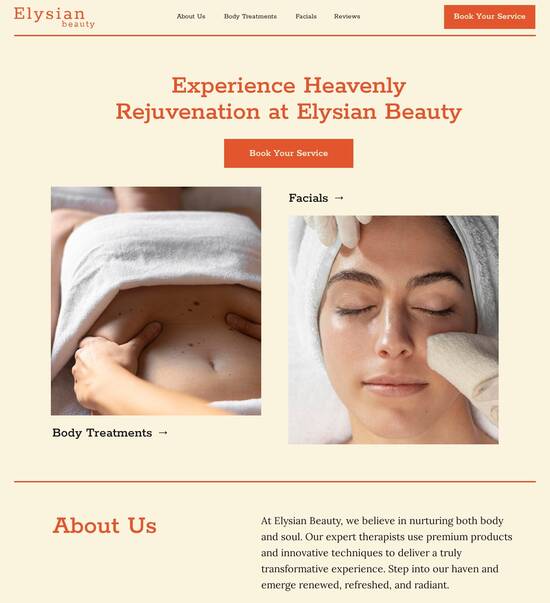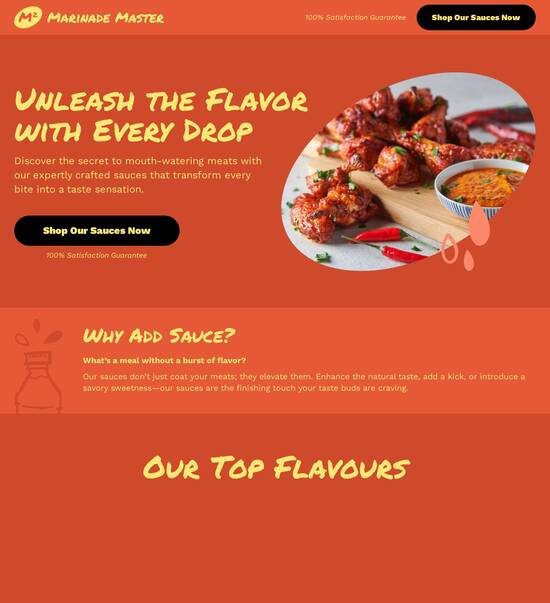
HTML page template with interactive project estimate form
Explore Similar TemplatesAbout template
Use HTML page templates with interactive project estimate form and make your communications easy and transparent. Try our solution today.
Recommended templates

Easy to build without coding
With the intuitive drag-and-drop builder, anyone on your team can create high-converting pages without any knowledge of code or design. Make enhancements to your landing page with custom widgets using Javascript, HTML/CSS, or third-party scripts.

Multiple layouts for any industry and goal
Select from 500+ landing page layouts built to boost conversions across industry-specific scenarios. Customize them by adjusting fonts, adding images, and generating on-brand content with the AI assistant. Quickly scale with Instablocks® and Global Blocks that you can save, reuse, and update globally.

Loads fast and looks polished on any device
Every template is responsive, which means they present professionally on any device and load blazingly fast with our Thor Render Engine. You can also power them up with Google AMP technology to deliver an unparalleled mobile experience and drive higher conversions.

Robust analytics & experimentation
Get real-time updates and reporting across all your devices, showing the number of visitors, conversions, cost-per-visitor, and cost-per-lead. Launch AI-powered experiments, run A/B tests, and use heatmaps to analyze user behavior, then optimize your landing page to maximize conversions.







Easy to build without coding
With the intuitive drag-and-drop builder, anyone on your team can create high-converting pages without any knowledge of code or design. Make enhancements to your landing page with custom widgets using Javascript, HTML/CSS, or third-party scripts.
Multiple layouts for any industry and goal
Select from 500+ landing page layouts built to boost conversions across industry-specific scenarios. Customize them by adjusting fonts, adding images, and generating on-brand content with the AI assistant. Quickly scale with Instablocks® and Global Blocks that you can save, reuse, and update globally.
Loads fast and looks polished on any device
Every template is responsive, which means they present professionally on any device and load blazingly fast with our Thor Render Engine.
Robust analytics & experimentation
Get real-time updates and reporting across all your devices, showing the number of visitors, conversions, cost-per-visitor, and cost-per-lead. Launch AI-powered experiments, run A/B tests, and use heatmaps to analyze user behavior, then optimize your landing page to maximize conversions.
All the features you need to build lead-generating landing pages
Explore more featuresLearn how to build top-performing landing pages for any goal
FAQs
Leading the way in building high-performing landing pages





A comprehensive guide to using Instapage for creating high-converting landing pages
Instapage empowers marketers with its advanced landing page and conversion rate optimization platform. This step-by-step guide will walk you through the essential process of utilizing Instapage to maximize your marketing campaigns, enhance user experience, and ultimately boost your ROI. By leveraging the platform's powerful features, you can create high-converting landing pages tailored to your audience's specific needs.
Understanding the basics of landing pages
Landing pages are standalone web pages created for a specific marketing campaign, designed to drive conversions by prompting visitors to take a specific action. The design, content, and functionality of these pages play a crucial role in influencing user behavior. Instapage offers over 100 customizable templates for various industries which can make getting started seamless and effective.
- Conversion-focused design: Instapage's templates are optimized for conversions, ensuring that every element contributes to the overall effectiveness of the landing page.
- User-friendly editor: The drag-and-drop editor simplifies the page creation process, allowing users to create stunning landing pages without any coding skills.
- A/B testing capabilities: Instapage enables you to conduct A/B tests for continuous optimization, helping you compare different versions of your landing pages to determine the most effective designs and layouts.
Step 1: Choosing the right template
The first step in creating an effective landing page is selecting the right template that resonates with your campaign's goals.
- Identify your target audience: Consider the needs and preferences of your unique audience to tailor the message effectively.
- Match with campaign goals: Choose a template that aligns with your specific marketing objectives, whether it’s lead generation or product sales.
- Utilize visual elements: Select a design that uses visuals strategically to capture attention and communicate your offer clearly.
Step 2: Crafting compelling content
After choosing a template, focus on crafting content that communicates your offer clearly and persuasively.
- Headlines matter: Create a strong headline that grabs attention and clearly states the value of your offer.
- Clear calls-to-action: Use prominent CTAs that drive the desired action, whether it's signing up, purchasing, or requesting a demo.
- Address audience pain points: Highlight how your offer solves specific challenges faced by your audience.
Step 3: Optimize and personalize your page
The final step is to optimize your page for conversions and add personalized elements.
- Utilize heatmaps: Leverage Instapage's heatmap feature to gain insights into user behavior and optimize areas for higher engagement.
- A/B testing for optimization: Regularly test variations of your landing page to determine which elements lead to higher conversion rates.
- Dynamic text replacement: Use personalization techniques to tailor content for different audience segments, making your landing pages even more relevant.
By following these steps, you can effectively create landing pages that not only attract visitors but also convert them into customers.
Ready to transform your marketing campaigns? Sign up for Instapage today and start creating landing pages that drive results!
People also ask about HTML page template with interactive project estimate form
HTML page template with interactive project estimate form
Understanding the essentials of project estimates and quotes
Project estimates play a vital role in the planning and execution of any project. They represent an approximation of the costs involved and are essential for budgeting purposes. A project estimate includes various elements, such as labor, materials, and overhead costs, providing a comprehensive view of potential expenses. Accurate estimates are crucial for successful project management, as they help avoid overspending or unexpected costs during project execution.
Quotes differ from estimates in their format and intent. While an estimate is an approximation that provides a general idea of costs, a quote is a fixed price that a service provider can guarantee. The choice between using a quote or an estimate often depends on the project's nature. An estimate allows flexibility in early project discussions, while a quote is more definitive and is ideally presented when a client is ready to agree.
Creating a solid foundation: HTML page template basics
An HTML page template serves as a foundational structure for creating web pages efficiently. It contains predefined layouts and styles which simplify the design process. Using templates not only saves time but also ensures consistency across multiple pages. They facilitate rapid creation and updates, allowing for a streamlined web development process.
When it comes to interactive estimate forms, specific components are essential. Key fields should include customer details, project descriptions, and a detailed cost breakdown. Additional interactivity can be incorporated, engaging users further and enhancing their experience. This form can automate calculations and provide immediate feedback, making the estimating process more user-friendly and efficient.
Designing a user-friendly interactive project estimate form
Designing an interactive estimate form that is user-friendly requires attention to layout and aesthetics. An intuitive design not only attracts users but also guides them through the estimating process smoothly. Choosing the right color scheme, typography, and maintaining layout consistency can significantly enhance user engagement. For instance, using contrasting colors can help important fields stand out, while clear typography ensures that text is legible.
Central to the form are the fields that capture vital project information. Essential fields include the project name, client details, task descriptions, pricing, and expected durations. However, optional fields can also play a critical role. Features such as discounts, tax calculations, and fields for supplementary notes can provide clients with a comprehensive insight into their project estimates.
Real-time cost calculations as users fill out fields.
Drop-down menus for task selection and predefined estimates.
File upload functionalities for project documents.
Leveraging estimate templates in various industries
Different industries require specialized project estimates based on varying needs. For example, in construction projects, labor, materials, and equipment costs are vital. Here, the estimate fields might be tailored to include specific categories that help clients visualize their expenses better. By organizing estimates based on industry requirements, businesses can communicate more effectively with clients.
Freelancers also benefit from custom estimates, particularly those in creative fields. Their templates must reflect time and deliverables based on client requirements. While some freelancers may need generic templates, others may require specific details that align with their unique services. Thus, understanding the audience is paramount in crafting relevant estimates.
Construction: Labor and materials cost breakdown.
Freelancing: Deliverables and time estimates.
Business services: Professional credibility through detailed estimates.
Estimates processing and customer interaction
Communicating effectively with customers is vital in the estimates process. Integrating fields in the estimate form for customer feedback can enhance the negotiation process. Clients appreciate transparency, and allowing them secure access to their submitted estimates helps foster trust. Providing options for revising estimates based on customer inputs promotes a collaborative atmosphere.
Improving the finalization of agreements is essential, and incorporating digital signatures or approval fields can expedite this process. Such features not only streamline the workflow but also offer legal assurance for both parties. Keeping track of changes and revisions during the estimate lifecycle ensures that all parties stay informed and can refer to different versions when necessary.
Format versatility: supporting various file formats
The versatility of an HTML estimate form lies in its ability to export data. By providing options to save estimates in formats like PDF, Word, and Excel, businesses can easily share and print these documents. This flexibility caters to clients' preferences, enabling them to keep a physical copy or share it with others, which is often crucial in business settings.
Following an estimate, transitioning into an invoice while maintaining branding consistency is important for customer satisfaction. Utilizing a well-defined hand-off process can minimize confusion and enhance the client experience, allowing for seamless interactions from estimating to billing.
Optimizing project estimate forms for effectiveness
To ensure that interactive estimate forms perform effectively, continuous testing and iteration are required. A/B testing different versions can provide valuable insights into user preferences and engagement metrics. Collecting user feedback enables businesses to refine their forms, improving the overall customer experience while making the estimating process more intuitive and simple.
Furthermore, employing analytics tools can help track form submissions, providing metrics on conversions linked to estimates. Analyzing such data allows businesses to make informed decisions and optimize their estimating processes further, enhancing both efficiency and user experience.
Integrating HTML estimate forms with business tools
Linking interactive estimate forms to customer relationship management (CRM) systems and project management tools can vastly improve workflow efficiency. Syncing estimates with existing business software allows project managers to track client interactions from estimating to execution seamlessly. This integration helps streamline processes, ensuring that every team member has access to the right information.
Additionally, automation can play a crucial role in refining the estimates process. Automating follow-up reminders for outstanding estimates can significantly increase response rates and reduce manual errors. This not only saves time for businesses but also serves to enhance client engagement and satisfaction.
The future of interactive estimate forms
As technology continues to evolve, the landscape of project estimates is shifting towards automation and AI integration. Emerging technologies are likely to enhance the capabilities of estimate forms, allowing for real-time data analysis and predictive analytics. This means businesses can make estimates based on historical data, tailoring quotes to more accurately reflect current market conditions and specific client needs.
User expectations are also changing, with customers wanting personalized experiences. To meet these demands, businesses need to balance advanced features with simplicity in design. Understanding how to create user-friendly forms that still incorporate customization will be key to maintaining client satisfaction moving forward.
Ready to skyrocket conversions?
Supercharge your ad campaigns with high-performing landing pages
Get started














